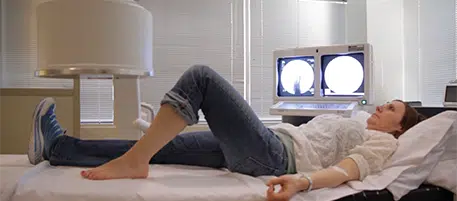Platelet Rich Plasma (PRP)
Platelet Rich Plasma (PRP) injections use your own concentrated blood platelets to promote healing. When injected directly into an injury site, PRP can lead to a more rapid, efficient and thorough restoration of the tissue to a healthy state by stimulating the body’s natural healing response.
PRP injections can be effective throughout the musculoskeletal system, including shoulders, elbows, wrists, hands, hips/pelvis, knees, ankles and feet, for a variety of injuries that include:
- Tendinosis/tendonitis
- Acute and chronic muscle strains and tears
- Ligament sprains
- Osteoarthritis
- Disc degeneration
- Fracture healing in special circumstances
What You Need to Know
- A small amount of blood will be taken from your arm. The blood is placed into a centrifuge to separate red blood cells and other components from the platelets to produce PRP. Using imaging guidance to monitor the position of the needle within the injured tissue, the radiologist will inject the PRP.
- Immediately following the injection, the PRP releases cellular growth factors that trigger the body’s healing response. You may experience inflammation and soreness as the body’s healing process begins. There may be no symptom relief for a period of two to eight weeks. You will want to treat the injected area with care as you would with a new injury. Depending on the area that is injured, crutches or a sling may be recommended to minimize use of the area as healing begins.
- In the months that follow, inflammation and pain will decrease and new tissue will begin to develop. As this tissue matures, it repairs and strengthens the tendons, ligaments, discs or joints. Pain and inflammation will decrease as this occurs.
- Frequently, chronic injuries require more than one injection. Depending on the severity and duration of the injury, an additional PRP injection may be suggested.
- Regenerative medicine procedures are not covered by insurance and do not count toward your deductible. Some health savings accounts and health reimbursement accounts may cover the cost of the procedures – check with your HSA or HRA administrator to learn more about your specific plan allowances. Payment for your procedure is due in full at the time of service.
- Research and clinical data show regenerative medicine injections using a patient’s own biologic material are extremely safe. There is minimal risk for any adverse reaction or complication.
- Because the cells are harvested from your own body, there is no concern for rejection or disease transmission.
- This procedure is not performed in all of our centers. Please contact the location or region nearest you for more information or to schedule an appointment.
What to Expect
- If your doctor requested a regenerative medicine consultation, you will meet with our doctor or nurse practitioner who will talk through your symptoms and review any relevant imaging you may have.
- If you do not have recent images of the area of concern, we may recommend ordering additional imaging to assess your injury or the location of your pain, discomfort or immobility
- If you are a candidate for a regenerative medicine procedure, we will work with you to schedule the procedure and help you prepare for a successful treatment.
- We will contact you prior to your appointment to review medications you are currently taking, your medical history, potential risks and answer any of your questions.
- If you have an active infection and are taking antibiotics, the procedure should be postponed until the infection is treated.
- Avoid taking anti-inflammatory medications, such as ibuprofen, Naproxen and aspirin, for 2 weeks prior to the procedure.
- Do not take any oral or injected steroids for 8 weeks prior to the injection.
- Contact your doctor before you stop taking any medication.
- Be sure to tell us if you are pregnant, nursing, or if there is a chance you may be pregnant.
- On the day of your procedure, please arrive 15 minutes early to check-in and bring prior imaging results with you, if instructed.
- You will need someone to drive you home following the procedure.
- The entire process takes approximately 60 minutes, which includes collection, concentration and injection of PRP into an injury site.
- Your arm will be cleaned and blood will be taken from your arm.
- The blood sample is placed in a centrifuge, which separates the platelets from the other components in order to generate a powerful concentrate to promote healing.
- The injured area will be cleaned and numbed.
- A board-certified radiologist with expertise in image-guided spine and joint injections will inject the concentrated platelets into the injured area using imaging guidance to ensure proper placement.
- Immediately following the injection, the platelets will begin releasing cellular growth factors that trigger the body’s healing response.
- Our technologists will provide detailed instructions for you to follow after your procedure.
- You may experience an “achy” soreness at the site of the injury in the hours and days following the injection. The effect can last for several days, gradually decreasing as healing and tissue repair occurs.
- You will want to treat the injected area with care, like you would with a new injury.
- Avoid taking anti-inflammatory medications, such as ibuprofen, Naproxen and aspirin, for three months post-procedure. These medications can block the intended healing response facilitated by the post-injection inflammation.
- Do not take any oral or injected steroids for three months post-injection.
- Avoid icing the treated area for two weeks.
- To maximize the healing process, no strenuous activity is advised for two weeks following your procedure. Activity may be increased as tolerated.
- Following this period of rest, you may resume normal day-to-day activities and light exercise.
- A physical therapy program will enhance the success of the treatment.
- Most patients begin noticing improvement four to eight weeks following the procedure. Increased stability and strength are typically reported along with a decrease in pain.
- You will need to schedule a follow-up appointment after your procedure.
- Most patients require only a single treatment, depending on the degree of injury. However, in challenging cases, if you experience significant relief that plateaus, a second injection may be indicated.

 Platelet Rich Plasma (PRP) Injections Offer Hope for Pain Relief
Platelet Rich Plasma (PRP) Injections Offer Hope for Pain Relief  Ease the Pain of Aging with Platelet Rich Plasma (PRP)
Ease the Pain of Aging with Platelet Rich Plasma (PRP)